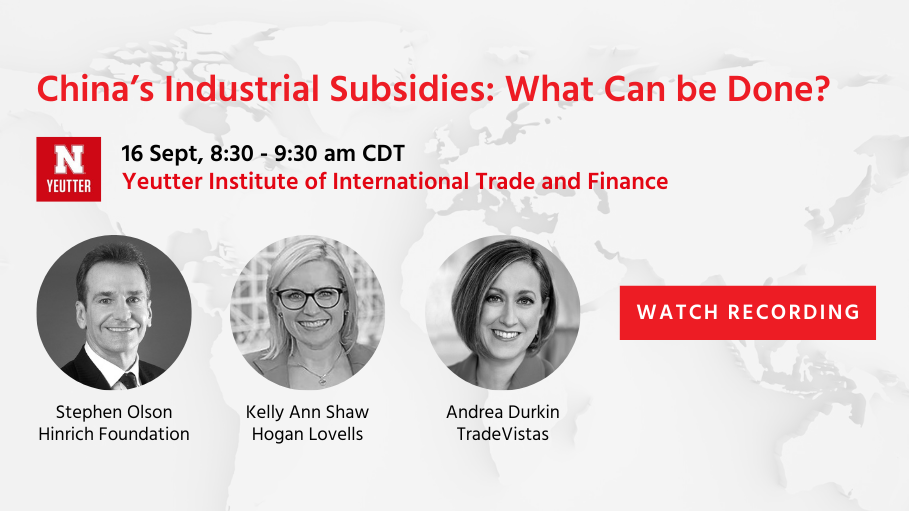China’s Industrial Subsidies: What Can Be Done?
Published 16 September 2020
Hinrich Foundation Research Fellow Stephen Olson discussed China’s industrial subsidies and the role of state-owned enterprises in the Chinese economy in a webinar hosted by Nebraska’s Clayton Yeutter Institute of International Trade and Finance on September 16, 2020.
The event, titled “China’s Industrial Subsidies: What Can Be Done?”, was organized by the Yeutter Institute to discuss the Chinese government’s subsidies to favored industries and the role of state-owned enterprises. It also discussed the overarching role of the state in the Chinese economy, which is at the core of US-China trade tensions and has not been addressed in phase one trade deal.
The webinar was moderated by Andrea Durkin, Editor-in-Chief of TradeVistas and Founder of Sparkplug, LLC. The panelists included:
- Stephen Olson, Research Fellow, Hinrich Foundation
- Kelly Ann Shaw, Partner, Hogan Lovells
In the opening remark, Olson pointed out the sheer magnitude of China’s subsidies. China provides subsidies that are equivalent to about 3% of its GDP, which is about the same portion of GDP as the United States governments spend on defense. He further said that China’s subsidies are at the heart of the government’s industrial policies and they, in turn, are at the heart of China’s state-directed capitalism.
Olson further said that the current international trade rules cannot cope with China’s centrally managed economy and its state-directed capitalism. The current trade rules were built on the Washington consensus based on free markets, and free trade principles. China is playing the game by a different set of rules and as the size and technological sophistication of China’s economy have increased, these two different systems are increasingly bumping up against each other.
“The existing trade rules are inadequate to meaningfully adjudicate these increasing points of friction and that’s certainly the case on the issue of subsidies,” Olson said.
In her remark, Shaw stated that China’s economic model spans sectors and industries where there is no clear separation between the private sector and the government. Shaw noted that in China, private companies can be directed by some facets of the government. There is a blurred line between government intervention and what is purely commercial in the marketplace.
On the ways China provides subsidies, Olson pointed out that the Chinese government provides subsidies in the form of a cash infusion from either government-directed or government influenced investment funds. It also provides low-cost electricity and land, concessionary loans from governmental policy banks, and through a sophisticated network of state-owned enterprises.
“Subsidisation is particularly acute in aluminum and steel industry, where the manufacturers get indirect subsidies because the inputs come from the large Chinese steel mills at an unusually low-cost,” Olson said.
Shaw explained the cumbersome process of litigating at the WTO against the subsidies provided by the Chinese government. Olson pointed out that a long process gives industries in China the first movers advantage. “Justice delayed is justice denied,” Olson said while quoting the example of Boeing and Airbus conflict at the WTO, which has been an ongoing issue between the US and the EU for the past 15 years.
On the collaboration between the US, Japan, and the EU for resolving subsidies issues, Olson said that the “pandemic is impacting every aspect of people’s lives and we shouldn’t be surprised that COVID-19 is going to impact the way we deal with subsidies as we have seen in the aftermath of the economic slowdown is that many countries have been forced to resort to subsidization in different forms to counteract the economic situation. I think countries will be a little bit more reticent about the right time to increase disciplines on subsidies.”
Olson concluded that all the core issues, particularly the industrial subsidies, cannot be solved through the trade agreements as many of the issues are fundamental and nettlesome. “We can try to make progress on a multilateral level. We can push the envelope further with like-minded countries but we also should be ready to take some of the issues unilaterally as per the trade remedy laws at our disposal.”
© The Hinrich Foundation. See our website Terms and conditions for our copyright and reprint policy. All statements of fact and the views, conclusions and recommendations expressed in this publication are the sole responsibility of the author(s).


